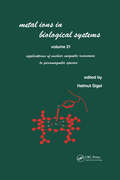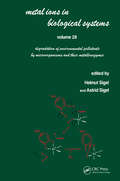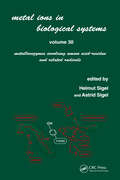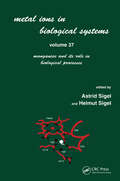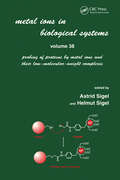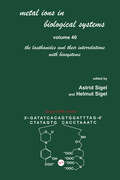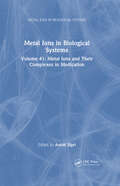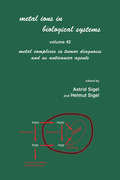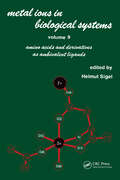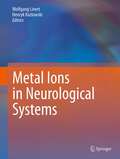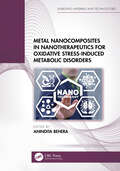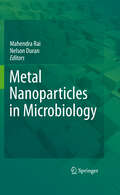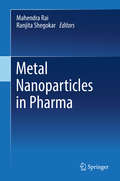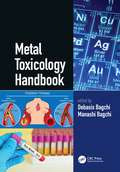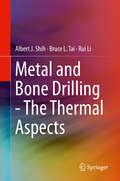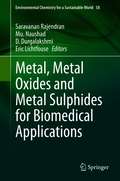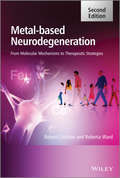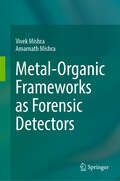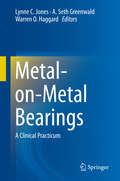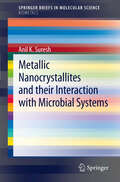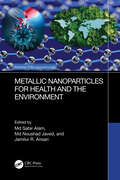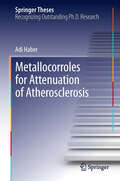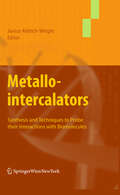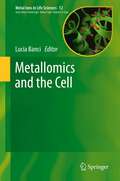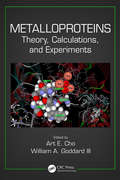- Table View
- List View
Metal Ions in Biological Systems: Volume 21: Applications of Magnetic Resonance to Paramagnetic Species (Metal Ions in Biological Systems)
by Astrid Sigel Helmut SigelThis book facilitates a wider use of nuclear magnetic resonance in studies of paramagnetic species. It summarizes studies of magnetically coupled metalloproteins, of paramagnetic heme proteins, and of metal-porphyrin-induced dipolar shifts for conformational analysis.
Metal Ions in Biological Systems: Volume 28: Degradation of Environmental Pollutants by Microorganisms and Their Metalloenzymes (Metal Ions in Biological Systems)
by Astrid Sigel Helmut SigelContinuing to explore the relationship between the chemistry of metals and life processes, this volume in the Metal Ions in Biological Systems series examines the degradation of environmental pollutants by micro-organisms. It covers the action of micro-organisms and metalloenzymes on lignin, tannins, hemicelluloses, cellulose and aromatic compounds, as well as on halogenated aromatics and aliphatics; analyzes mechanistic aspects; considers the role of metalloproteases in biotechnology and wastewater sludge treatment; and describes the metal-dependent conversion of inorganic nitrogen and sulfur compounds.
Metal Ions in Biological Systems: Volume 30: Metalloenzymes Involving Amino Acid-residue and Related Radicals (Metal Ions in Biological Systems)
by Astrid Sigel Helmut SigelThis volume is devoted solely to the research area of metalloenzymes involving amino acid-residue and related radicals. Topics covered include: general considerations; structure, function and engineering of peroxidases; and ribonucleotide reductase in mammalian systems.
Metal Ions in Biological Systems: Volume 37: Manganese and Its Role in Biological Processes (Metal Ions in Biological Systems)
by Helmut Sigel"Highlights the availability of magnesium to organisms, its uptake and transport in microorganisms and plants as well as its role in health and disease of animals and humans including its toxicology."
Metal Ions in Biological Systems: Volume 38: Probing of Proteins by Metal Ions and Their Low-Molecular-Weight Complexes (Metal Ions in Biological Systems)
by Astrid Sigel Helmut SigelVolume 38: Probing of Proteins by Metal Ions and Their Low-Molecular-Weight Complexes focuses on the vibrant area of probing enzymes or proteins by metal ions and small complexes. It offers a summary of the basic characteristics of the amide bond, emphasizing its proton and metal ion interactions, including a quantitative analysis of its hydrolysis and formation. Topics include Peptide bonds, footprinting, protein degradation, protein complexes, and protein cross-linking.
Metal Ions in Biological Systems: Volume 40: The Lanthanides and Their Interrelations with Biosystems (Metal Ions in Biological Systems)
by Astrid Sigel Helmut SigelMany may know lanthanides under the homier name of rare earth elements, but that is less used scientifically because they are, in fact, not at all rare. Highlighting fast-moving research on lanthanides and their interrelations with biosystems, this book emphasizes the recent impact of these metals in biochemical, biological, and medical research, including in magnetic resonance imaging (MRI). The first two chapters outline their abundance and distribution, chemical properties such as oxidation states and ionic radii, and their mobilization through microorganisms like bacteria and fungi. It is written by 38 internationally recognized experts and enriched with nearly 200 illustrations and 1900 references.
Metal Ions in Biological Systems: Volume 41: Metal Ions and Their Complexes in Medication (Metal Ions in Biological Systems #Vol. 41)
by Patrick Graupp Robert J. WronaMetal ions are currently used for such applications as diabetes, anti-inflammatory, rheumatoid arthritis, psychiatric, and anti-ulcer medications, using compounds of vanadium, copper and zinc, gold, lithium, and bismuth, respectively. This text explores these applications in addition to an assessment of chelation therapy, uses in environmental scie
Metal Ions in Biological Systems: Volume 42: Metal Complexes in Tumor Diagnosis and as Anticancer Agents (Metal Ions In Biological Systems Ser. #28)
by Astrid Sigel Helmut SigelOffering an authoritative and timely account by twenty-nine internationally recognized experts, Metal Ions in Biological Systems: Metal Complexes in Tumor Diagnosis and as Anticancer Agents is devoted solely to the vital research area concerning metal complexes in cancer diagnosis and therapy. In fourteen stimulating chapters, the book focuses on d
Metal Ions in Biological Systems: Volume 9: Amino Acids and Derivatives as Ambivalent Ligands (Metal Ions in Biological Systems)
by Helmut SigelThis book focuses on the connection between the chemistry of metal ions and their role for life, and covers complexes with a number of amino acids with chelatable side chain donor atoms. It discusses metal ion-protein interactions and the ligating ambivalency of nucleotides.
Metal Ions in Neurological Systems
by Henryk Kozlowski Wolfgang LinertMetal ions in the brain are a necessity as well as a poison. The presence of metal ions in the active sites of biological catalysts or metalloproteins and in the biological functioning of nucleic acids is very well documented and they are required for brain activity. On the other hand, metals are very effective in generating oxidative stress. This effect does not only play a role in immunology but also is the root of practically all neurodegenerative disorders by inducing disease via the death of neurons. Managing metal ions in the brain could therefore be an important strategy in the search for therapeutic agents used in the treatment of neurodegenerative diseases. This new title gives an overview to key topics in the area of metal ions in the brain. It focuses on the role of metal ions in neurological systems by describing their advantageous functions as well as their poisonous features. It is therefore of interest for scientists in biochemistry and biophysics, physiology, toxicology as well as for physicians focused on this topic.
Metal Nanocomposites in Nanotherapeutics for Oxidative Stress-Induced Metabolic Disorders (Emerging Materials and Technologies)
by Anindita BeheraThis book highlights the role and mechanism of different metal nanocomposites toward oxidative stress-induced metabolic disorders including metabolic pathways affected by oxidative stress and related pathophysiology. The book includes an illustrative discussion about the methods of synthesis, characterization, and biomedical applications of metal nanocomposites. It focuses on the therapeutic approaches for metabolic disorders due to oxidative stress by nano delivery systems. Moreover, the book includes chapters on nanotherapeutic approaches toward different diseases, including diabetes mellitus, obesity, cardiovascular disorders, cancers, and neurodegenerative diseases such as Alzheimer's disease and Parkinson's disease. This book is aimed at researchers and graduate students in nanocomposites, nano delivery systems, and bioengineering. Features Discusses nanocomposites in the field of therapy for diabetes, obesity, cardiovascular disorders, neurodegenerative diseases, and cancers Details the pathophysiology of oxidative stress-induced metabolic disorder Explains mechanisms of the antioxidant potential of metal nanocomposites Discusses pathways to elucidate the therapeutic activity Reviews specific and precise applications of metal nanocomposites against lifestyle-induced disorders
Metal Nanoparticles in Microbiology
by Mahendra Rai Nelson DuranFollowing an introduction to biogenic metal nanoparticles, this book presents how they can be biosynthesized using bacteria, fungi and yeast, as well as their potential applications in biomedicine. It is shown that the synthesis of nanoparticles using microbes is eco-friendly and results in reproducible metal nanoparticles of well-defined sizes, shapes and structures. This biotechnological approach based on the process of biomineralization exploits the effectiveness and flexibility of biological systems. Chapters include practical protocols for microbial synthesis of nanoparticles and microbial screening methods for isolating a specific nanoparticle producer as well as reviews on process optimization, industrial scale production, biomolecule-nanoparticle interactions, magnetosomes, silver nanoparticles and their numerous applications in medicine, and the application of gold nanoparticles in developing sensitive biosensors.
Metal Nanoparticles in Pharma
by Mahendra Rai Ranjita ShegokarCompletely dedicated to the biomedical applications of metal nanoparticles, this book covers the different toxicity problems found in healthcare situations and also provides comprehensive info on the use of metal nanoparticles in treating various diseases. Metal Nanoparticles in Pharma is the first edited volume to set up the discussion for a clinical setting and to target a pharmaceutical audience of academic and industry-based researchers.
Metal Toxicology Handbook
by Debasis Bagchi and Manashi BagchiHeavy metals and metalloids, singly or in combination, induce toxic manifestations either through acute or chronic pathology. In particular, long-term chronic exposure to diverse heavy metals and metalloids to humans and animals can lead to numerous physical, muscular, neurological, nephrological, and diverse degenerative diseases and dysfunctions, including multiple sclerosis, muscular dystrophy, Parkinson’s and Alzheimer’s diseases, cardiovascular disorders, and several others. Recognized heavy metals such as lead, mercury, arsenic, cadmium, thallium, and hexavalent chromium are known for enormous toxicity. The immediate vital signs of acute heavy metal exposure include nausea, vomiting, diarrhea, and acute abdominal pain. Mercury has been identified as the most toxic heavy metal, and mercury poisoning is known as acrodynia or pink disease. Similarly, lead, another toxic heavy metal, was at one time an integral part of painting. Metal Toxicology Handbook further explains and discusses the varying attributes of metals, discussing toxicity, safety, and proper human utilization of metals. Beginning with a broad overview of metals, metalloids, redox biology, and neurodegeneration and going further into the roles, benefits, and toxicity of metals with each section, the text contains 28 chapters from eminent researchers and scientists in their respective fields and is a must-have for anyone researching the potential toxicity in metals. Key Features Discusses the pathology of metal toxicity Highlights the benefits of metals Explains the mechanism and salient features of restoring metabolic homeostasis Highlights dose-dependent beneficial and adverse effects of vanadium safety and toxicity The initial introductory section provides a broad overview of metals, metalloids, redox biology, and neurodegeneration. The second section discusses the pathology of metal toxicity in two chapters, while the third section highlights the mechanism and salient features of restoring metabolic homeostasis in two chapters. The fourth section demonstrates the aspect of radionuclides toxicity. In a change of pace, the fifth section discusses the benefits of metals in four chapters. The sixth section, titled "Toxic Manifestations by Diverse Heavy Metals and Metalloids," provides fourteen chapters that discuss the toxicological mechanism and manifestation of individual metals. The editors have crafted a commentary titled "A Treatise on Metal Toxicity" and summarized a vivid scenario of metal toxicity and its consequences.
Metal and Bone Drilling - The Thermal Aspects
by Rui Li Albert J. Shih Bruce L. TaiThis book introduces state-of-the-art experimental and numerical methods and examples for evaluating the drilling performance of engineering and biological materials, particularly in thermal aspects. The authors use a common pathway to present the technological and analytical methods for both industry (metal) drilling and orthopaedic surgery (bone) drilling research, making this book a resource for both industrial and clinical readers who wish to understand the evolution of technologies, techniques and challenges in drilling. The authors also focus on advanced engineering materials, such as titanium alloys and high-strength cast irons, which have broad applications in the automotive, aerospace, medical device and sports industries. This book is a must-read for a broad audience, including engineering students in upper-level undergraduate and graduate courses that involve machining processes; for surgery residents, fellows, and practicing surgeons; and for engineers in the medical device industry who develop new bone cutting tools.Bridges the knowledge on drilling from the manufacturing industry to healthcare;Covers the experimental and modeling aspects of drilling thermal analysis;Includes experimental studies that contain parameters and data that emulate practical production and clinical drilling.
Metal, Metal Oxides and Metal Sulphides for Biomedical Applications (Environmental Chemistry for a Sustainable World #58)
by Eric Lichtfouse Mu. Naushad Saravanan Rajendran D. DurgalakshmiThis book presents recent advances in inorganic nanomaterials for healthcare, with focus on the synthesis, medical applications and toxicity of metals, metal oxides and metal sulfides. Major applications include diagnosis, bioimaging, biosensing, healing and therapy in cancer, diabetes, cardiovascular diseases, obesity, metabolic syndrome, dentistry and antimicrobials.
Metal-Based Neurodegeneration
by Robert Crichton Roberta WardNeurodegenerative diseases of the human brain appear in various forms, resulting in disorders of movement and coordination, cognitive deterioration and psychiatric disturbances. Many of the key factors leading to neurodegenerative diseases are similar, including the dysfunction of metal ion homeostasis, redox-active metal ions generating oxidative stress, and intracellular inclusion bodies.Metal-based Neurodegeneration presents a detailed survey of the molecular origins of neurodegenerative diseases. Each chapter is dedicated to a specific disease, presenting the latest scientific findings, including details of their biochemical actors (proteins or peptides), their normal and pathological conformations, and a description of the diseases characteristics, with an emphasis on the role of metal-induced oxidative stress, which can result in the production of intracellular aggregates of target proteins and peptides. Topics covered include:Brain function, physiology and the blood-brain barrierImmune system and neuroinflammationAging and mild cognitive impairment, MCIParkinson's DiseaseAlzheimer's DiseaseCreutzfelt-Jakob and related prion diseasesAlcoholic Brain DamageTherapeutic strategies to combat the onset and progression of neurological diseasesThis extensively updated, full colour, second edition of Metal-based Neurodegeneration is an essential text for research scientists and clinicians working in gerontology, neuropathology, neurochemistry, and metalloprotein mechanisms.
Metal-Organic Frameworks as Forensic Detectors
by Vivek Mishra Amarnath MishraThis book illustrates the application of Metal-Organic Frameworks (MOFs) based detectors and scientific methods in the Forensic sciences. The introductory chapter provides metal-organic frameworks as materials for applications in sensors and reviews their photochemical and electrochemical properties. The subsequent chapter probes the interaction between Metal-Organic Frameworks and forensic samples. Further, the chapters discuss the applications of the metal-organic framework for the detection of fingerprint latent, lip-print, palm-print, pesticides, and antibiotics in forensic samples. Further, the chapters review the use of metal-organic frameworks for the detection of drugs of abuse, explosives, hazardous chemicals, and gunshots residual. Towards the end, the chapter reviews the advantages and disadvantages of MOFs during forensic sample detection and current challenges and prospects. This book provides useful information on applications of metal-organic Frameworks for forensic scientists and legal professionals.
Metal-on-Metal Bearings
by Lynne C. Jones A. Seth Greenwald Warren O. HaggardThis book addresses the background and significance of the factors potentially influencing the clinical and biological outcomes of metal-on-metal hip implants. Metal-on-metal bearings were introduced and evaluated as an alternative to other bearing couples, particularly metal-on-polyethylene, due to their enhanced wear resistance as determined in laboratory testing. Initially, reports of short-term clinical outcomes were favorable and an increasing number of metal-on-metal prostheses were implanted. Subsequently, isolated case findings describing adverse tissue responses around the articulation became the harbinger of an increasing number of reports describing pseudotumors and other significant lymphocytic-based responses associated with metal-on-metal prostheses. Questions have been raised as to whether this is an implant, design, or patient-specific response. The reasons why some patients have a negative biological response and pathology while others do not remain to be determined, but tens of thousands of patients in the US, the UK, and around the world are considered to be at risk. Leading researchers and clinicians describe the issues related to the nature of the biological and pathological responses and the protocols that should be followed to determine if an adverse response is occurring. This book is essential reading for researchers, engineers, and orthopaedic surgeons who are involved in the design, evaluation, and implantation of metal-on-metal prostheses.
Metallic Nanocrystallites and their Interaction with Microbial Systems
by Anil K. SureshAlthough interactions between nanoparticles and microorganisms in the environment are unavoidable and commonplace, it is still not clear what potential effects they may have. Metallic Nanocrystallites and their Interface with Microbial Systems not only illustrates how microbes and these particular nanoparticles interact but also it describes the consequences of these interactions. This brief discusses the impact of gold, silver, zinc oxide, and cerium oxide nanoparticles on the growth and viability of both Gram-negative and Gram-positive bacterium. Moreover, it analyses the relationship between bacterial growth inhibition, reactive oxygen species generation, the regulation of transcriptional stress genomes, and the toxicity of these materials. Finally, it reviews the specific metallic nanomaterials and highlights their modes of synthesis, reactivity at surfaces, and the importance of assay procedures in determining their toxicity levels. Various microscopy techniques used to determine their mechanisms of action are also presented. Metallic Nanocrystallites and their Interface with Microbial Systems will be a valuable source to the scientific and industrial community as well as to students and researchers in microbiology, biotechnology, nanotechnology, toxicology, materials science, biomedical engineering, cell and molecular biology.
Metallic Nanoparticles for Health and the Environment (Advances in Bionanotechnology)
by Md Sabir Alam Md Noushad Javed Jamilur R. AnsariMetallic Nanoparticles for Health and the Environment covers different routes of synthesis for metallic nanoparticles and their process variables. Both the functions and roles of these particles as a drug delivery system and diagnostic agent and other potential theranostic purposes against metabolic disorders, photocatalysis applications, as well as wastewater treatments, are discussed. The book compares the different properties of bulk metallic forms and their nanoparticulated forms. It discusses the mechanisms and impacts of different process variables in different synthesis routes, as well as emerging trends in clinics and so forth. Features: Covers different routes of synthesis to create metallic nanoparticles (MNPs) of different characteristics with reference to bulk forms of metals. Describes formulation parameters that have a significant effect on these MNPs including dimensions, morphology, mechanism, surface properties, and other characteristics. Discusses different roles and performances of MNPs in photothermal therapy, metabolic disorders, mechanisms in bacterial, fungal, and viral infections, and inflammatory pathways. Reviews the potential and emerging roles of different MNPs with site target delivery applications and genetic manipulation purposes. Examines the advantages and challenges of these MNPs against remediation of pollutants and toxicants, owing to their superior surface catalytic activities. This book is aimed at researchers and professionals in nanomaterials, pharmaceuticals, and drug delivery.
Metallocorroles for Attenuation of Atherosclerosis
by Adi HaberAdi Haber's thesis summarises the use of a new entity, the corrole, to combat one of the major cardiovascular diseases, atherosclerosis. She examines the effects of three rationally designed corrole-metal complexes on some of the many variables which contribute to the development of atherosclerosis. There is a focus on both the "bad" and "good" cholesterol carriers, LDL and HDL. Adi Haber proceeds from basic findings in pure chemistry through biochemical and cell culture tests to in vivo examinations. The work in this thesis shows that corroles are highly efficient both for early and late treatment of atherosclerosis in animals. These results will pave the way for ongoing regulated preclinical studies focussed on the development of metallocorroles as potential drugs for treating cardiovascular diseases.
Metallointercalators
by Janice Aldrich-WrightA comprehensive treatment of the characterisation techniques used in investigating inorganic and organic molecules that interact with biomolecules is presented to the reader in a clear fashion. The work consists of two parts: (i) synthetic aspects of metallointercalators along with targeting and improving transport and (ii) the various techniques that are used for probing their interactions, such as; DNA-NMR, PGSE-NMR, DNA ESI-MS, Linear and Circular Dichroism, Fluorescence Spectroscopy, Confocal Microscopy, Viscosity, TGA and dialysis, Microarrays, biological analysis. Chapters are devoted to the synthesis and the techniques used to study the interactions of inorganic complexes with biomolecules. Considerably detailed examples are used to help illustrate the application of these techniques. This book is a useful resource for an array of inorganic and organic advanced undergraduate and graduate courses and for researchers in drug discovery.
Metallomics and the Cell
by Lucia BanciMetallomics and the Cell provides in an authoritative and timely manner in 16 stimulating chapters, written by 37 internationally recognized experts from 9 nations, and supported by more than 3000 references, several tables, and 110 illustrations, mostly in color, a most up-to-date view of the "metallomes" which, as defined in the "omics" world, describe the entire set of biomolecules that interact with or are affected by each metal ion. The most relevant tools for visualizing metal ions in the cell and the most suitable bioinformatic tools for browsing genomes to identify metal-binding proteins are also presented. Thus, MILS-12 is of relevance for structural and systems biology, inorganic biological chemistry, genetics, medicine, diagnostics, as well as teaching, etc.
Metalloproteins: Theory, Calculations, and Experiments
by Art E. Cho William A. Goddard IIINumerous essential biological functions involve metalloproteins; therefore, understanding metalloproteins and how to manipulate them is significant in the biological and medical fields. An examination of current research, Metalloproteins: Theory, Calculations, and Experiments explores the interplay between theory and experiment, detailing the role
